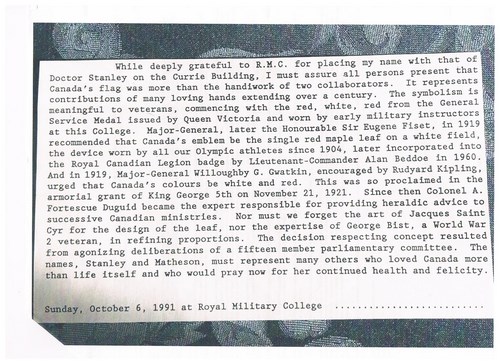The National Flag of Canada is 60 years old, let us remember the many loving hands who worked so diligently to bring the most recognized and respected symbol of Canada to fruition.
The year was 19 hundred and 65, what a wonderful time to be alive. Our Prime Minister Lester B. Pearson made good on his promise to have a unifying, truly Canadian Flag by the time we were to celebrate our Centennial in 1967.
This was a monumental task which was attempted back in 1925 and again in 1946 only to become a political hot potato and abandoned by the governments of the day.
Mr. Pearson brokered the Suez Peace accord in 1956 and was awarded the Noble Peace Prize. During his work he offered up our Canadian Peace Keepers only to have this offer rejected because Canadian Soldiers worn a British Red Ensign on the uniforms and could be mistaken for British Soldiers.
Mr. Pearson was so disappointed that he made himself a promise to do whatever he could to have a National Flag of Canada brought into being.
People such as Heraldry enthusiast Edward M. Chadwick in 1895 had suggested Canada have its very own Flag and should have a Maple Leaf on it. Then there was Major-General (later) Sir Eugene Fiset who in 1919, while writing to his boss Thomas Mulvey about the changes needed for the Armorial Bearing of Canada, sited “a single red maple leaf on a white field with 2 red bourders, if it were to be a flag.
Lester B. Pearson was elected as the Leader of the Liberal Party of Canada in 1958, and one of the party platform items was to bring a National Flag of Canada to fruition when the Liberal Party formed Government.
Meanwhile in May of 1961, John Ross Matheson was elected in a by-election as the Liberal MP for Leeds (now Leeds & Grenville). Mr Matheson was a lawyer practising Law in Brockville Ontario since 1948, he was also known as an extremely knowledgeable Heraldry enthusiast along with his best friend George M. Beley ( 2 of the founders of the Heraldry Society of Canada).
This event prompted Mr. Pearson to assign Mr. Matheson the task to begin researching what it would take to bring Canada it’s very own symbol . The execution of this research would become the tireless dedication of (the man who was most responsible) for bringing the National Flag of Canada to fruition in 1965.
Mr. Pearson became the Prime Minister of Canada in 1963. Now Mr. Matheson’s work became more important in its process. In the following year the Pearson Government had officially proclaimed the need to have a truly unifying National Flag of Canada and government formed a parliamentary “Flag Committee” to complete this task. The committee was made up of 12 members of Parliament from all official parties. This committee was given 6 weeks to achieve consensus (September 10-October 22)
Many people provided suggestions of exactly what a Canadian flag should be. One of the people Mr. Matheson requested advice from was Dr. George Stanley from RMC. Dr. Stanley suggested the flag be a single red maple leaf on a white field with 2 red borders, this suggestion would become the basis of what became the National Flag of Canada. It must be noted there were 2465 suggestions made during the flag committee deliberations.
Mr. Matheson commonly known as (Father of our Flag) would always refer to all of the people who helped to bring our flag into being as the (many loving hands) who participated in so many ways, from the initial ideas, concepts, research and advice to the actual team who were responsible for the final design and creation of the most recognized symbol of Canada around the entire world. On November 9th 1964 this team was comprised of Patrick Reid Manager of Graphic Design for Expositions Canada who brought along his very best creative/graphic designer Jacques St. Cyr (who created/designed the stylized 11 point Maple Leaf). George Bist an advertising executive from Toronto who had provided the details for the actual proportions of our flag ( 2:1 provides a very unique visual balance, our flag is 2 times as long as it is in height, the white centre pale is exactly 2 times the size of the red borders. The red and white colours of our Flag represent the (unofficially proclaimed) National Colours of Canada, by King George V in 1921. The colour of red was established by Dr. Gunter Wyzsecki and his team from the National Research Council of Canada and was the first time in history that a scientific colour was created for a National Symbol.
The political wrangling which took place from 1961 through 1964/65 was a testament to this emotionally driven debate in which our Parliamentarians often found themselves in conflict with their own knowledge and the ability to explain the identity of Canada.
In the end the “flag committee” got the job done, their conclusion was sent to Parliament on October 29th 1964 and the debate was absolutely vicious. Through some very difficult and ingenious communications the minority Government was able to get passed the turmoil with a vote on December 15th 1964 at 2:13 am of 163 to 78. The Senate of Canada passed into law on December 17th 1964. Queen Elizabeth the Second proclaimed the National Flag of Canada on January 28th 1965. Our new Canadian Flag was first raised on February 15th 1965.6
Please take some time to remember all of the hard working people who make it possible for Canadians to live, work and play in the best country in the entire world. We have a symbol which is one of the most respected and recognized around the globe, let us all celebrate February 15th 2025 as the 60th birthday of the National Flag of Canada and “fly the Maple leaf” with pride and honour.
Respectfully,
Robert J. Harper
Executive Director
Canadian Flag Education Centre
